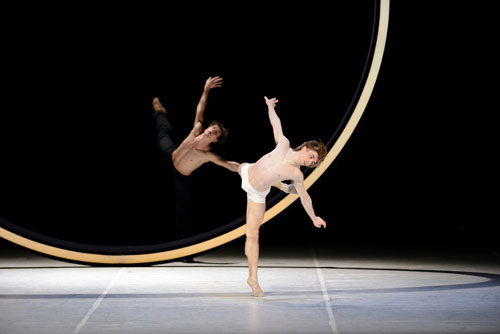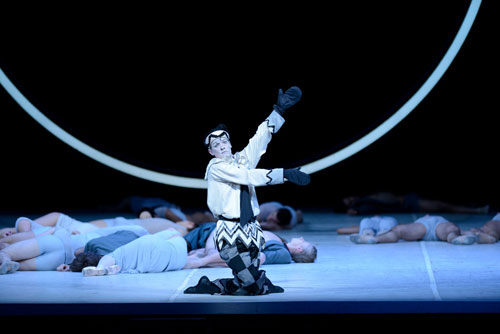|
John's Neumeier's "Nijinsky" begins at the scene of the dancer's final performance, January 19, 1919, in a Swiss ballroom. Here Vaslav Nijinsky, long considered among the greatest dancers, if not the greatest dancer of the 20th century, abruptly ended his career. In Neumeier's rendering, the scene is at once a collage of Nijinsky's thoughts as he descends into schizophrenia, but also a period fashion show.
This bizarre juxtaposition of fashion and madness felt disconnected and lacked perspective. The audience members who actually attended Nijinsky's final performance may well have paraded around in the latest fashions of the day without knowledge of Nijinsky's fragile state but why would Neumeier have found this so important that he opened this evening-long work with it?
Watching the rest of the work I began to see that Neumeier had long ago lost perspective on his subject. He claims to have been obsessed with Nijinsky since he first picked up a book about him in his local library in Milwaukee, Wisconsin, at the age of 10. Throughout the proceeding decades he collected Nijinsky memorabilia and read everything he could get his hands on about the fascinating Russian choreographer and dancer.
And no wonder! Nijinsky's story is a captivating and heartbreaking biography of a young artist at the center of early 20th century creativity. Nijinsky starred in performances of the Ballets Russes that are legendary. Nijinsky choreographed "Le Sacre du Printemps," whose premiere performances were so controversial they caused near riots in Paris—by both the shocked audiences who attended and the angry outsiders who were unable to obtain tickets. Nijinsky's embodiment of characters as diverse as the sensual faun in his "L'Après-midi d'un Faune" and the lonely clown in Mikhael Fokine's "Petrouchka" revolutionized ballet by the depth of his transformations.
 |
Nijinsky devoted himself completely to transforming the way he and other dancers moved on stage. He rejected the idea of static poses and show-off stunts that had dominated ballet in the 19th century. He worked tirelessly to train his short, muscular body for long, quick, fluid chains of seamless motion. According to his sister, Bronislava Nijinska, who observed him in his solitary pursuits of his ideal, he drove himself to achieve feats that bewildered even her trained eye. He would glide across the floor executing complicated variations and then seemingly without preparation he would suddenly spin up to a dozen pirouettes.
Aside from his public life as an artist, Nijinsky's relationships were fraught and fascinating. During a time when homosexuality was a serious criminal offense in Russia, he carried on a highly public affair with another subject of great allure: Sergei Diaghilev, the founder and impresario extraordinare who created and dominated Les Ballets Russes.
While still involved with Diaghilev, Nijinsky married an adoring fan who had taken to following him throughout the world in a manner that today would be called stalking. And I have only barely mentioned his family which included a schizophrenic brother and a sister who devoted her life to his legacy.
But what really matters, what should matter in a ballet devoted to Nijinsky is his artistry, his influence and how his unique vision changed dance forever. Evidently, this is not how Neumeier sees it. Neumeier created an homage that is a very long smattering of images, excerpts and scenes, some real and some imagined by Neumeier, as he believed Nijinsky saw them. "Nijinsky" is a baffling stream-of-consciousness collage that overwhelms the subject as well as the audience.
It is not the dancers' fault. In fact, they all acquitted themselves with professionalism throughout the nearly three-hour ordeal. Featuring members of the Hamburg Ballet with guest appearances by dancers from the Canadian National Ballet, the cast included a total of about fifty beautifully trained dancers. Yes: fifty!
Guillaume Côté, as Vaslav Nijinsky, did the best he could, given the choreography. In the historical accounts of Nijinsky's final 1919 performance in Switzerland, Nijinsky walked out and sat in a chair staring at the audience. And this is what Neumeier asked of Côté. In a house as large as the San Francisco Opera House, it takes skill and even greater direction to captivate the hearts, minds and imagination of 3,000 people while sitting in a chair staring at them. As if to compensate for these and other weak dramatic moments throughout the piece, Neumeier then floods the stage with what he believes were Nijinsky's thoughts, memories and hallucinations. And when all of this fails to achieve a dramatic arc, Neumeier uses over-loud crescendos in the music to infuse drama.
 |
Neumeier is credited with the choreography, sets, costumes and lighting concepts. His costuming is mostly realistic except for one constant: he portrays the men either shirtless or without pants. This idea may have been symbolic of male vulnerability, as when Nijinsky and his shirtless lover, the domineering Diaghilev, dance a duet suggesting their symbiotic bond. In Act II, Neumeier directs dozens and dozens of dancers to march across the stage in military formations, military coats and no pants or shirts. War. Again, I tried to see it as a sign of the soldiers' youth, vulnerability and as a way of binding them together by their fundamental humanity. I may be reading far too much into it. It may simply be that Neumeier likes to look at men in various states of undress.
 |
Perhaps it is impossible for audiences today to be thrilled or even moved by what Nijinsky did on stage a hundred years ago. He laid the foundation for changes in the art form that took root and flourished. However, Neumeier's theatrical sensibilities, which tend toward overwhelming the audience with images, sound and lots and lots of people, do not leave room from any subtlety.
In a beautiful essay written by Cyril Beaumont about the world premiere performance of "Petrouchka" in 1911, he wrote that Nijinsky "suggested a puppet that sometimes aped a human being, whereas all other interpreters conveyed a dancer imitating a puppet."
What Neumeier gave us was a dancer imitating a dancer imitating a puppet.
Photos courtesy of San Francisco Ballet, © Erik Tomasson
|